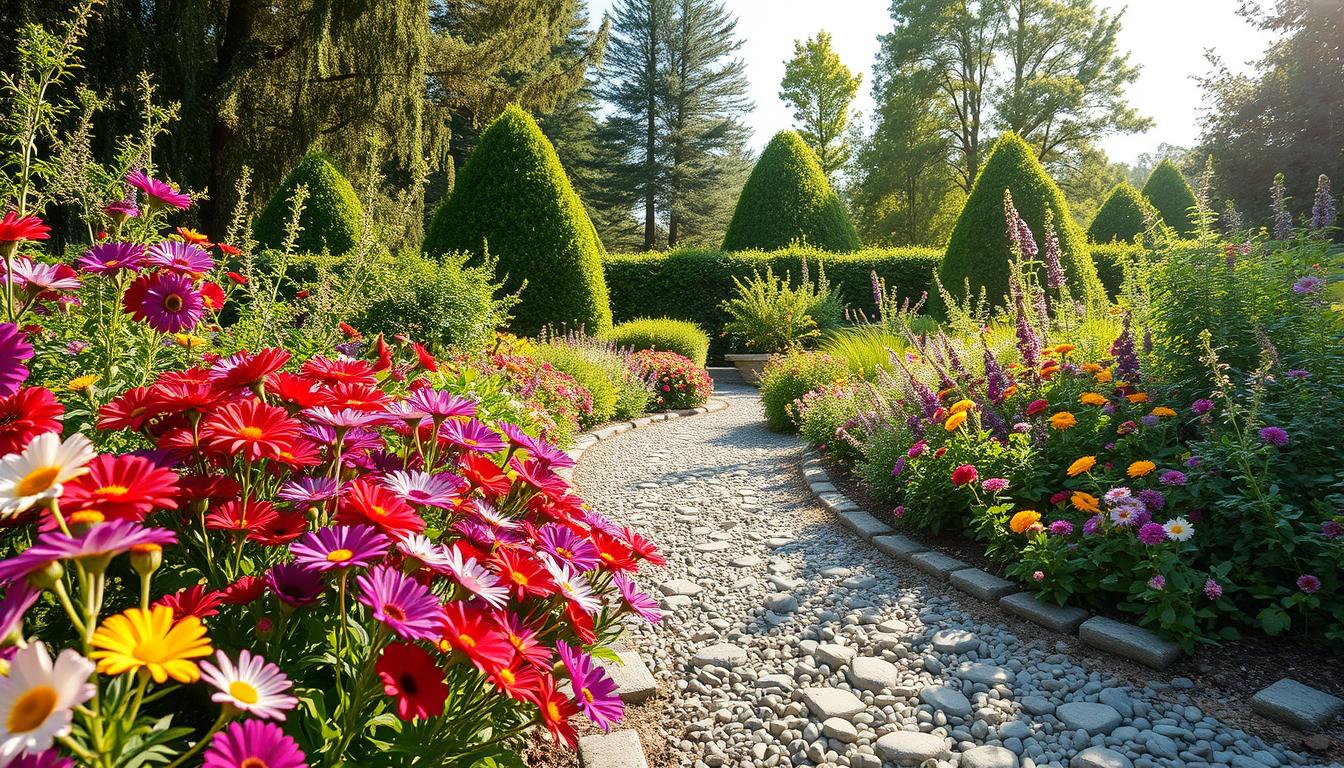Transforming your outdoor space into a vibrant retreat is easier than you think. With the right inspiration, you can create a stunning garden that reflects your personality and style. Whether you prefer a cozy cottage feel or a sleek modern look, there’s a design for every taste.
From wildflower meadows to raised beds, these ideas cater to all yard sizes. Seasonal blooms and thoughtful color palettes ensure year-round beauty. Plus, these designs don’t just look good—they support pollinators and boost curb appeal.
Ready to get started? Explore over 25 curated ideas to spark your creativity. Let’s turn your outdoor area into a place you’ll love.
Key Takeaways
- Discover over 25 curated ideas for your outdoor space.
- Explore diverse styles like cottage, Mediterranean, and modern themes.
- Adapt designs to fit any yard size effortlessly.
- Incorporate seasonal blooms for year-round beauty.
- Enhance functionality with pollinator-friendly features.
Why Flower Garden Designs Matter for Your Yard
Strategic garden planning enhances both beauty and functionality. A well-designed outdoor space not only looks stunning but also serves practical purposes. For instance, 90% of homeowners prioritize curb appeal when planning their front-yard layouts. This focus can boost property value by up to 15% with thoughtful flower bed placement.
Beyond aesthetics, gardens play a vital role in supporting local ecosystems. Pollinator-friendly designs increase biodiversity by 40%. Native plants like bee balm and coneflowers attract hummingbirds and butterflies, creating a lively and eco-conscious yard.

Landscaping also helps prevent soil erosion. Border gardens act as natural boundaries, keeping your soil intact during heavy rains. This combination of beauty and practicality makes garden designs a smart investment for any homeowner.
Seasonal blooms add year-round interest to your outdoor space. Spring tulip displays bring vibrant colors, while winter hellebores offer subtle elegance. Herb gardens are another excellent addition, blending aesthetics with functionality. They provide fresh ingredients for your kitchen while enhancing your yard’s charm.
| Benefit | Example |
|---|---|
| Boost Property Value | Strategic flower bed placement |
| Prevent Soil Erosion | Border gardens |
| Attract Pollinators | Native plants like bee balm |
| Seasonal Interest | Spring tulips, winter hellebores |
Whether you’re aiming for curb appeal or a sustainable outdoor space, thoughtful garden designs can transform your yard into a place you’ll love. Start planning today to enjoy these benefits year-round.
Choosing the Right Flowers for Your Garden
Selecting the perfect plants for your outdoor space can make all the difference. The right choices ensure a vibrant, sustainable, and visually appealing yard. Whether you’re a seasoned gardener or just starting, understanding what works best for your climate and style is key.
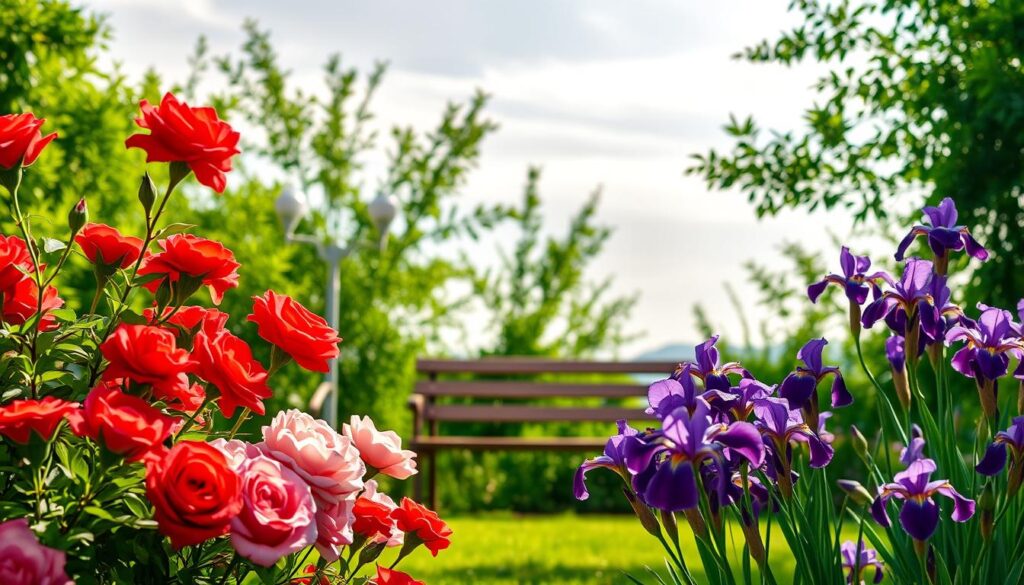
Native Flowers for a Sustainable Garden
Native plants are a smart choice for any outdoor area. They’re adapted to local conditions, requiring less water and maintenance. Plus, they support local wildlife, like bees and butterflies, boosting biodiversity.
For example, bee balm and coneflowers are excellent options. These plants thrive in various climates and add a pop of color to your space. By choosing native species, you’re not just gardening—you’re contributing to a healthier ecosystem.
Seasonal Blooms for Year-Round Color
To keep your yard vibrant throughout the year, focus on seasonal planting. Experts from Kew Gardens recommend a four-season strategy. This ensures your space always has something in bloom.
- Spring: Tulips and daffodils bring fresh energy after winter.
- Summer: Dahlias and hydrangeas thrive in the heat.
- Fall: Chrysanthemums and ornamental kale add warmth.
- Winter: Camellias and pansies provide subtle beauty.
Layering bulb depths also helps stagger blooming periods. Pair seasonal blooms with evergreen shrubs for a polished look.
| Season | Recommended Plants |
|---|---|
| Spring | Tulips, Daffodils |
| Summer | Dahlias, Hydrangeas |
| Fall | Chrysanthemums, Ornamental Kale |
| Winter | Camellias, Pansies |
With thoughtful planning, your outdoor space can be a year-round retreat. Start by selecting the right plants and blooms to match your vision and climate.
Creating a Pollinator-Friendly Garden
Supporting pollinators in your outdoor space is a rewarding way to boost biodiversity. By choosing the right plants, you can attract bees, butterflies, and other beneficial insects. This not only enhances your yard’s beauty but also contributes to a healthier ecosystem.
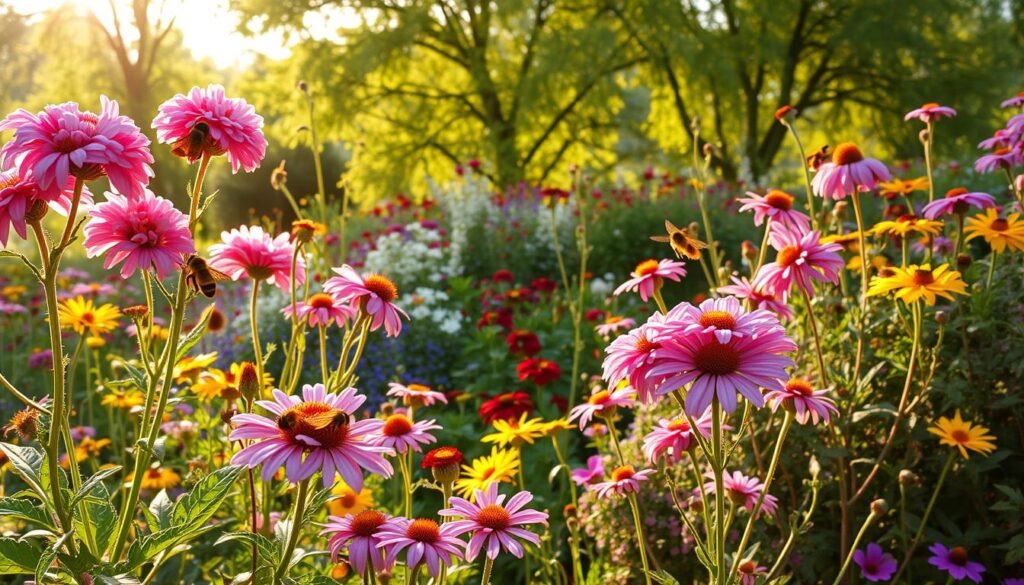
Studies show that butterfly populations increase by 90% in areas with milkweed. Similarly, lavender and salvia attract five times more bees than hybrid roses. These findings highlight the importance of selecting nectar-rich flowers for your space.
Here are some practical tips to create a haven for pollinators:
- Cluster nectar-rich plants like butterfly bush, lantana, and milkweed.
- Avoid pesticides and use marigolds as natural pest deterrents.
- Add shallow water sources, such as birdbaths with pebble perches.
- Include night-blooming jasmine to attract moths for 24/7 pollination.
These steps ensure your outdoor area is both beautiful and functional. A pollinator-friendly garden supports local wildlife while adding vibrant colors and life to your yard.
| Tip | Benefit |
|---|---|
| Plant milkweed | Boosts butterfly populations |
| Use lavender and salvia | Attracts more bees |
| Avoid pesticides | Protects pollinators |
| Add water sources | Supports hydration |
With these strategies, you can create a thriving space for butterflies, bees, and other pollinators. Start today and watch your yard come alive with activity and color.
Designing a Wildflower Meadow
A wildflower meadow adds natural beauty and supports local ecosystems effortlessly. Unlike traditional lawns, these meadows require minimal water—just 1” weekly compared to 3” for grass. This makes them a sustainable choice for any landscape.
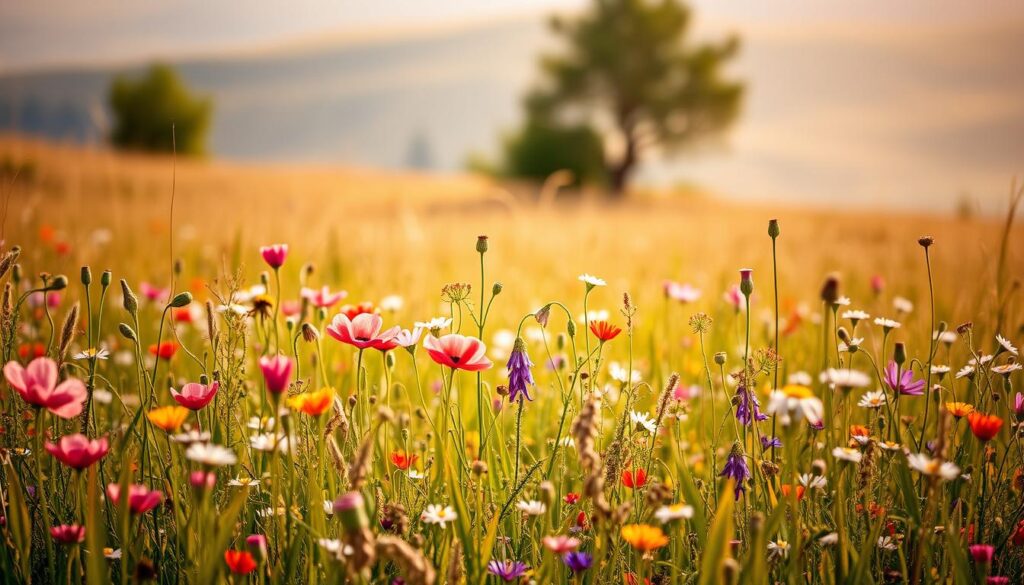
Carrie Spoonemore, a gardening expert, emphasizes, “Wildflowers support entire ecosystems.” They attract pollinators, reduce maintenance, and create a vibrant, natural look. Here’s how to get started:
- Prepare the soil by removing turfgrass and scattering seed mixes.
- Use a blend of 70% native wildflowers and 30% ornamental grasses for texture.
- Top choices include black-eyed Susans, blue flax, and crimson clover.
- Mow once annually in late fall to encourage reseeding.
These steps ensure your garden thrives with minimal effort. Wildflower meadows are perfect for adding color and life to your outdoor space while supporting local wildlife.
Incorporating Raised Flower Beds
Raised flower beds are a versatile and practical solution for enhancing your outdoor space. They offer a range of benefits, from improved soil drainage to easier maintenance. Whether you’re working with a small yard or a sprawling landscape, these beds can transform your area into a vibrant retreat.
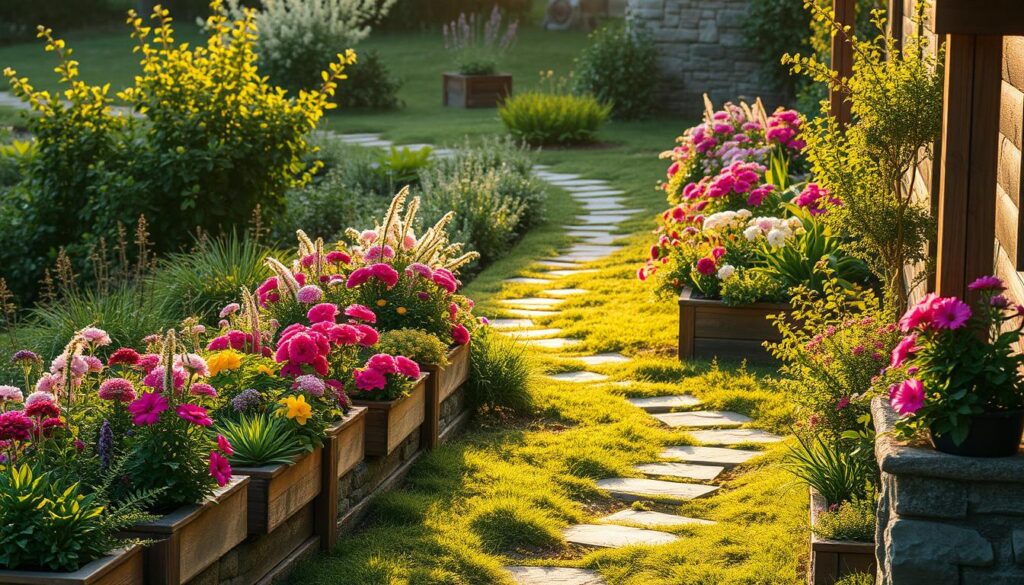
Benefits of Raised Beds
One of the biggest advantages of raised beds is their ability to improve soil quality. By controlling the soil mix, you can create the perfect environment for your plants to thrive. This is especially helpful in areas with poor native soil.
Raised beds also reduce strain on your back and knees. Their elevated design makes planting, weeding, and harvesting much easier. Plus, they offer better drainage, preventing waterlogging and root rot.
Another benefit is their versatility. You can customize the height and size to fit your space and needs. This flexibility makes them ideal for both beginners and experienced gardeners.
Design Ideas for Raised Flower Beds
When designing your raised beds, consider tiered layouts for added depth. This approach creates visual interest and allows you to grow a variety of plants in one area. Galvanized metal beds are a sleek option for modern yards.
For soft borders, edge your beds with trailing lobelia or sweet alyssum. These plants add a delicate touch while defining the edges of your flower beds.
Mix plants of different heights for a dynamic look. Combine tall snapdragons, mid-height cosmos, and creeping thyme for a layered effect. This combination adds texture and color to your outdoor space.
Finally, consider painting your beds in bold hues to complement your home’s exterior. This simple step can tie your garden design together, creating a cohesive and polished look.
Using Color to Enhance Your Garden
Color plays a powerful role in shaping the mood and perception of your outdoor space. Whether you’re aiming for a serene retreat or a vibrant oasis, the right palette can make all the difference. Studies show that monochromatic gardens can increase perceived space by 20%, making them ideal for smaller yards.
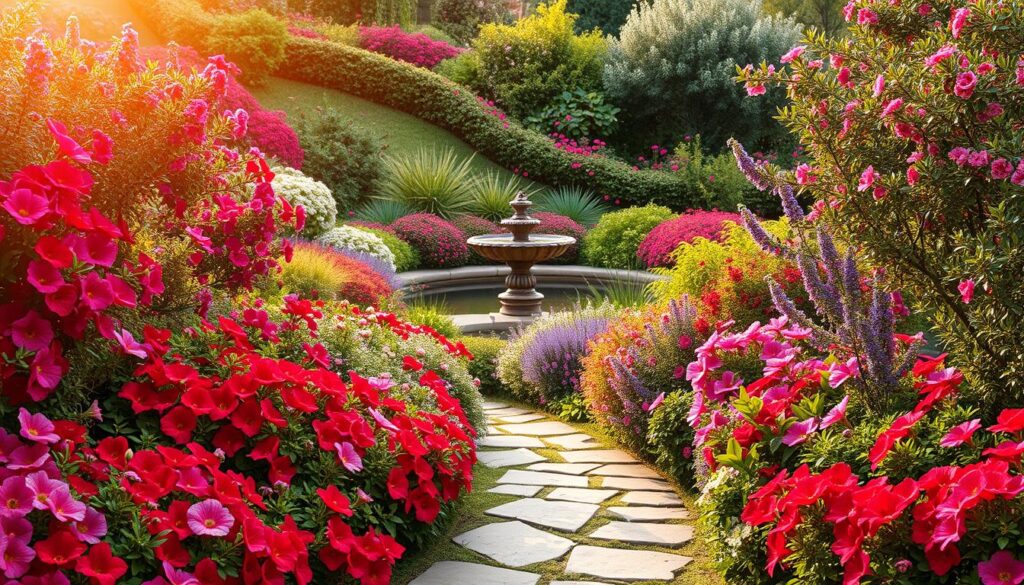
Warm tones like red and orange naturally draw the eye forward, creating focal points. Cool tones like blue and purple, on the other hand, recede, adding depth to your landscape. By balancing these hues, you can craft a dynamic and harmonious design.
Here are some practical ways to use color effectively:
- Create focal points with clusters of red dahlias or yellow coreopsis.
- Soften hardscapes by planting pastel peonies along stone pathways.
- Incorporate foliage like heuchera and Japanese maple for year-round interest.
By thoughtfully arranging flowers and foliage, you can transform your outdoor area into a visually stunning retreat. Start experimenting with color today and watch your garden come to life.
Creating a Cottage Garden Aesthetic
A cottage garden aesthetic brings charm and nostalgia to any outdoor space. This design combines vibrant flowers, lush greenery, and vintage elements for a cozy, romantic feel. It’s perfect for those who love a relaxed, whimsical vibe in their yard.
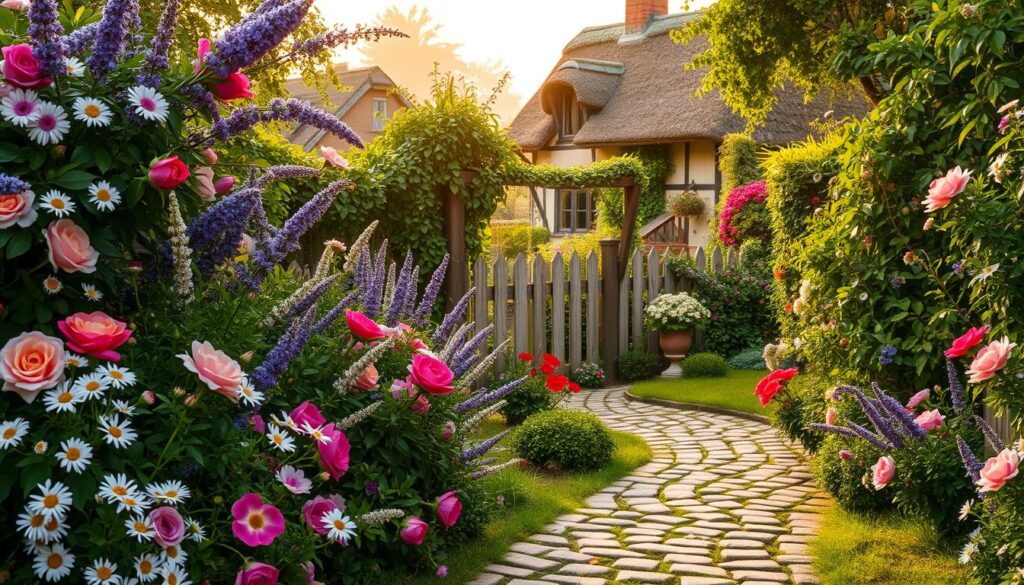
To achieve the signature “organized chaos” of a cottage garden, pair foxgloves with delphiniums. These tall, striking plants create layers of texture and color. Repeating 3-5 plant varieties ensures cohesion while maintaining a natural, unstructured look.
Here are some tips to bring this aesthetic to life:
- Plant rambling roses over arched trellises for vertical interest.
- Edge pathways with lavender and catmint to add fragrance and softness.
- Incorporate vintage touches like wrought iron gates and weathered benches.
These elements work together to create a space that feels both timeless and inviting. Whether you’re starting from scratch or updating an existing garden, a cottage-style layout is a beautiful way to enhance your outdoor area.
Designing a Mediterranean-Inspired Garden
A Mediterranean-inspired garden brings warmth and elegance to any outdoor area. This design thrives in sunny, well-drained soils, making it perfect for warm climates. Globe thistle and olive trees are excellent choices for creating a lush, sun-loving space.
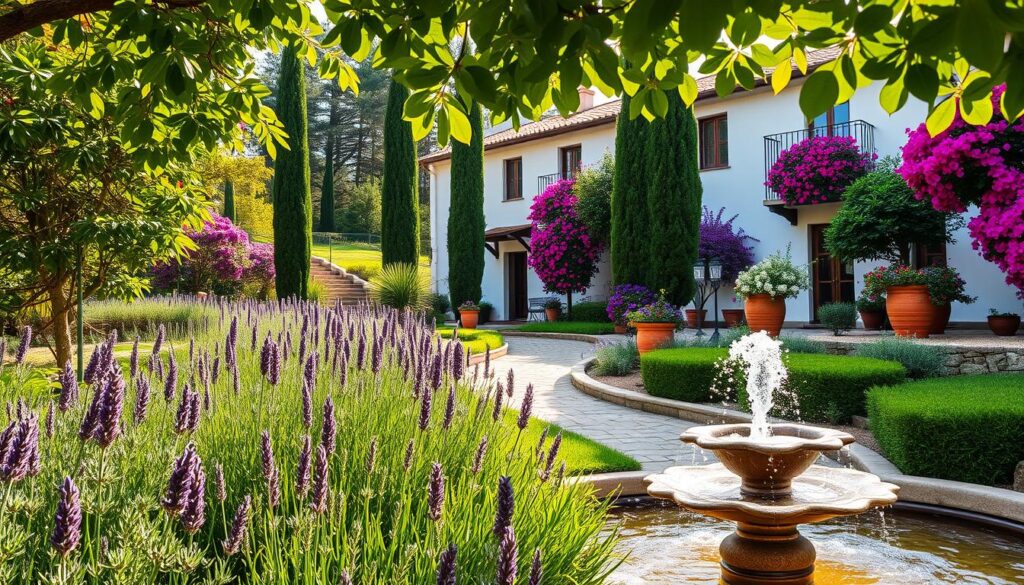
To achieve an authentic look, use gravel mulch and terracotta pots. These elements add texture and reflect the natural beauty of Mediterranean landscapes. Drought-tolerant plants like rosemary, sage, and Spanish lavender are ideal for this style. They require minimal water and add fragrance to your garden.
Incorporate shaded seating areas under pergolas for a functional and inviting touch. These spaces provide a cool retreat during sunny days, enhancing the overall appeal of your outdoor area.
| Element | Benefit |
|---|---|
| Gravel Mulch | Adds texture and reduces water evaporation |
| Terracotta Pots | Enhances authenticity and durability |
| Drought-Tolerant Plants | Requires less water and thrives in sunny conditions |
| Shaded Seating | Provides a cool, functional retreat |
With these tips, you can create a Mediterranean-inspired garden that’s both beautiful and sustainable. Start planning today to bring the charm of the Mediterranean to your outdoor space.
Adding Vertical Elements to Your Garden
Elevate your outdoor space with vertical elements that add depth and charm. By incorporating climbing plants, pergolas, and trellises, you can maximize your garden’s potential. These features not only enhance aesthetics but also create functional areas for relaxation and entertainment.
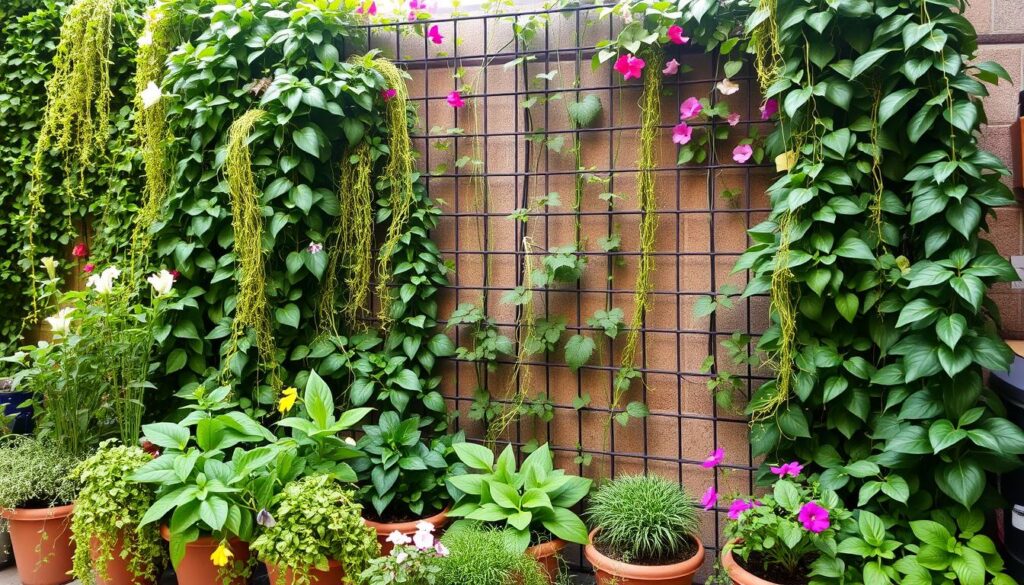
Climbing Plants for Vertical Interest
Climbing plants are a fantastic way to add height and texture to your garden. Varieties like wisteria, clematis, and ivy thrive on vertical structures, creating lush, green walls. Wisteria-covered pergolas, for example, can increase property value by 12% while adding a romantic touch to your outdoor space.
When selecting climbing plants, consider their growth habits and maintenance needs. Fast-growing options like morning glories provide quick coverage, while slower-growing varieties like climbing roses offer long-term beauty. Pair them with sturdy supports to ensure they flourish.
Using Pergolas and Trellises
Pergolas and trellises are versatile additions to any garden. They provide support for climbing plants and create shaded areas for seating. When choosing materials, match them to your home’s style. Cedar offers a natural look, while powder-coated metal adds a modern edge.
For a layered effect, hang baskets from pergola crossbeams. This adds visual interest and maximizes vertical space. Trellises can also be used to divide areas, creating intimate nooks within your garden.
| Element | Benefit |
|---|---|
| Climbing Plants | Add height and texture |
| Pergolas | Create shaded seating areas |
| Trellises | Divide spaces and support plants |
| Hanging Baskets | Enhance vertical layers |
With these tips, you can transform your garden into a multi-dimensional retreat. Start incorporating vertical elements today and watch your outdoor space come to life.
Designing a Low-Maintenance Flower Garden
A low-maintenance garden doesn’t mean sacrificing beauty or variety. With the right strategies, you can create a stunning outdoor space that requires minimal effort. Start by choosing drought-tolerant plants, which can reduce watering needs by up to 80%.
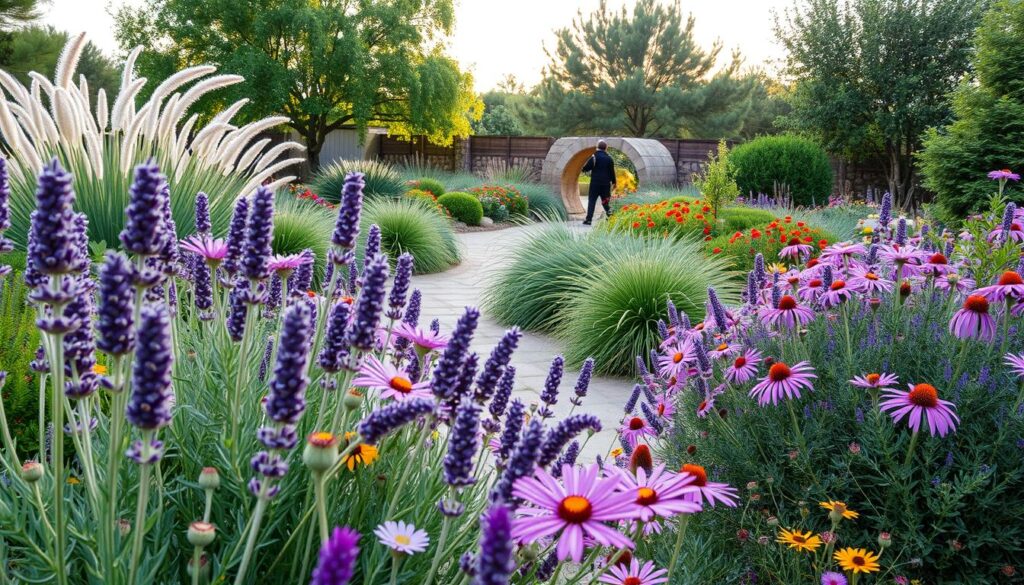
Mulching is another key step. Use bark chips to suppress weeds and retain moisture in the soil. This simple addition saves time and keeps your garden looking neat. Self-seeding perennials like columbine and coneflowers are excellent choices. They return year after year, reducing the need for replanting.
For efficient watering, install drip irrigation on timers. This system delivers water directly to the roots, minimizing waste and ensuring your plants stay healthy. These tips make gardening easier while maintaining a vibrant and thriving outdoor space.
Incorporating Edible Flowers and Herbs
Adding edible flowers and herbs to your outdoor space combines beauty with practicality. These plants not only enhance your garden’s visual appeal but also serve functional purposes. From pest control to culinary uses, they’re a smart addition to any design.
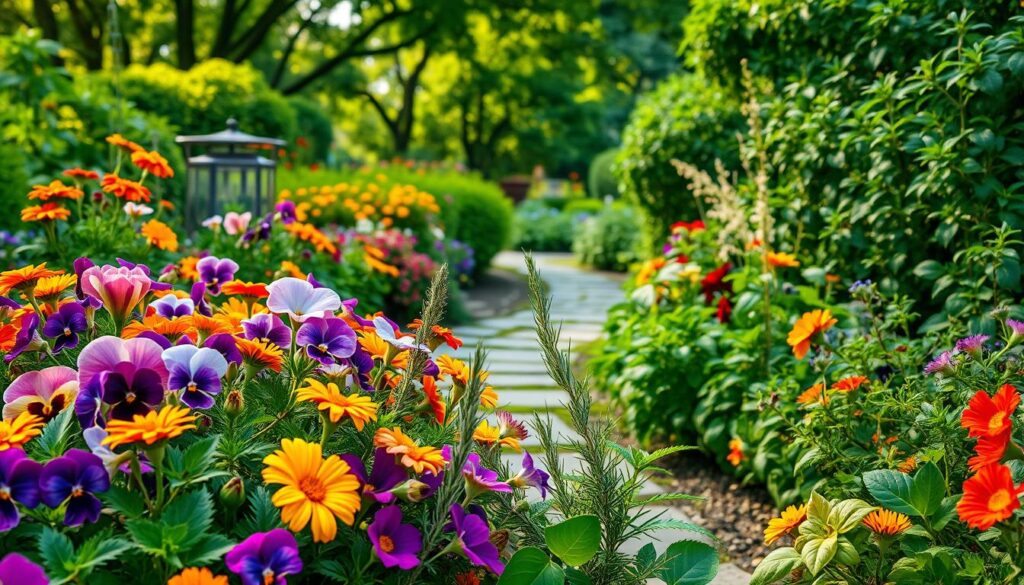
Lavender and basil are excellent examples. They deter pests naturally while being harvestable for cooking or aromatherapy. This dual purpose makes them a favorite among gardeners who value both aesthetics and utility.
Here are some tips to incorporate edible flowers and herbs effectively:
- Interplant nasturtiums with tomatoes to repel aphids and other pests naturally.
- Use chamomile as a fragrant ground cover that also attracts beneficial insects.
- Plant calendula for its bright blooms and edible petals, perfect for salads or garnishes.
These strategies ensure your garden is both beautiful and productive. Start experimenting with edible plants today to enjoy their many benefits.
| Plant | Benefit |
|---|---|
| Lavender | Deters pests, harvestable for aromatherapy |
| Basil | Repels insects, culinary uses |
| Nasturtiums | Natural pest control, edible flowers |
| Chamomile | Fragrant ground cover, attracts pollinators |
With these ideas, you can create a garden that’s as functional as it is beautiful. Incorporate edible flowers and herbs to enjoy the best of both worlds.
Creating a Sensory Garden
Engage all five senses with a thoughtfully designed sensory garden. This approach transforms your outdoor space into a multi-dimensional experience, connecting you with nature in new and exciting ways. From the rustle of ornamental grasses to the soothing sounds of wind chimes, every element is chosen to delight your senses.
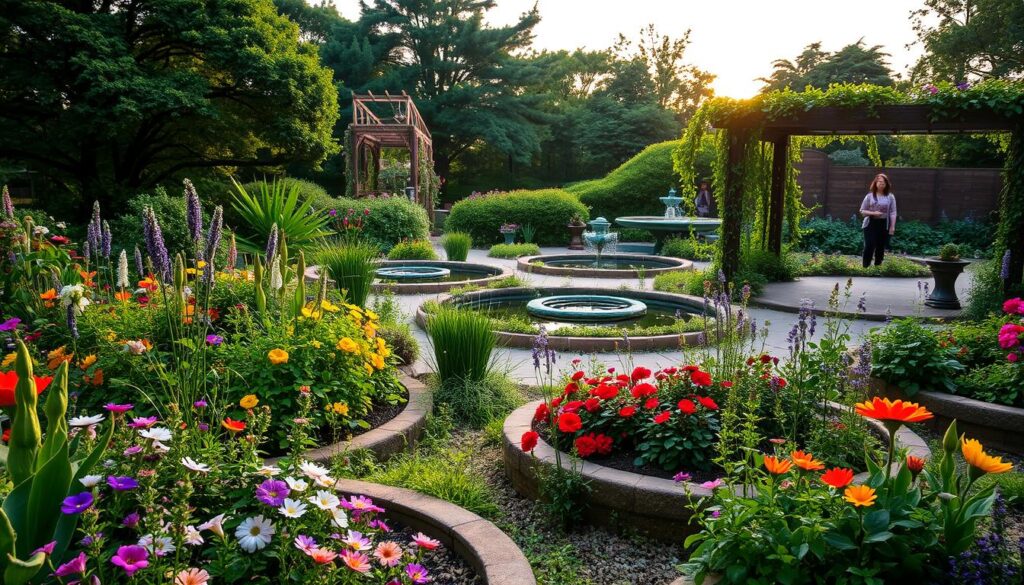
Include plants like lamb’s ear for tactile interest. Its soft, velvety leaves invite touch, making it a favorite for sensory gardens. For evening fragrance, plant night-blooming phlox. Its sweet scent fills the air after sunset, creating a calming atmosphere.
Here’s how to bring your sensory design to life:
- Add rustling ornamental grasses for auditory appeal.
- Incorporate wind chimes to enhance the soundscape.
- Plant lamb’s ear for a unique tactile experience.
- Include night-blooming phlox for evening fragrance.
These elements work together to create a garden that’s not just beautiful but also immersive. Start planning your sensory retreat today and enjoy a deeper connection with nature.
Designing a Flower Garden for Small Spaces
Small spaces offer unique opportunities for innovative garden designs. With the right approach, even the tiniest yards can become lush retreats. Vertical solutions, like trellises and tiered planters, maximize every inch of your space.
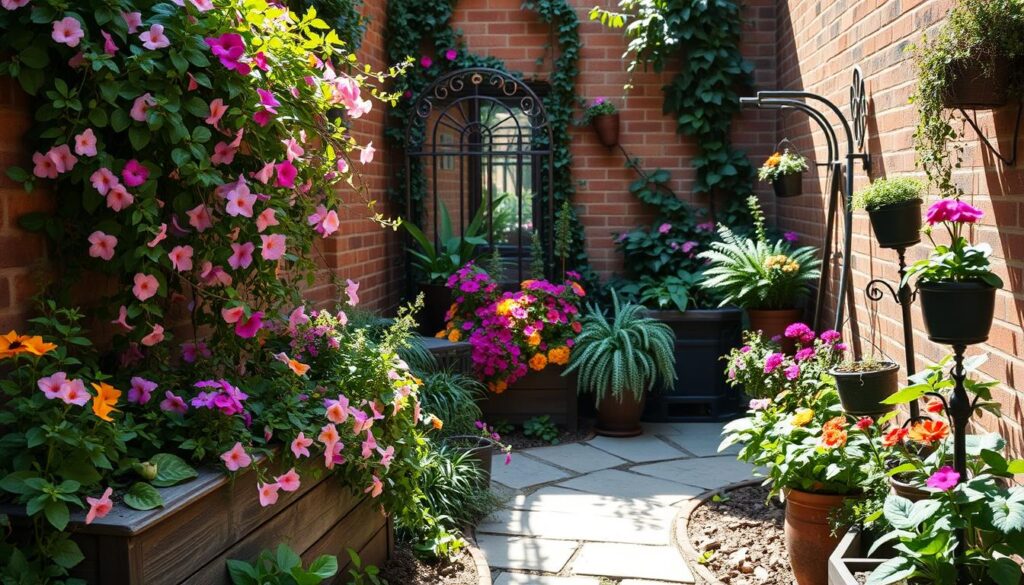
Vertical gardens are a game-changer, yielding twice the blooms per square foot. They’re perfect for balconies or patios where horizontal space is limited. Pair them with compact plants like ‘Petite Plum’ coneflowers for a vibrant display.
Here are some tips to make the most of your small garden:
- Use tiered planters to create layers of flower beds.
- Opt for dwarf varieties that thrive in confined areas.
- Incorporate hanging baskets for added vertical interest.
With thoughtful planning, your small design can feel spacious and inviting. Start experimenting today and watch your compact area bloom with life.
Using Hardscape Elements in Your Garden
Hardscape elements can transform your outdoor space into a functional and beautiful retreat. These features add structure, balance, and practicality to your landscape, creating a cohesive and inviting environment. From pathways to decorative accents, hardscape elements are essential for any well-rounded design.
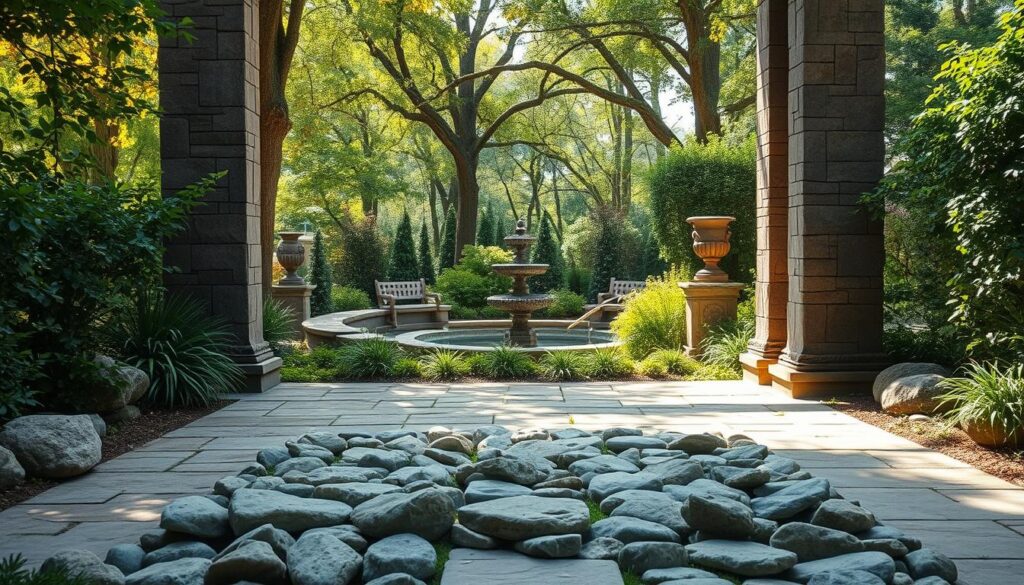
Paths and Walkways
Paths and walkways are more than just functional—they guide visitors through your yard while adding visual interest. Materials like gravel, stone, or brick can complement your garden’s style. For example, a gravel path offers a rustic charm, while flagstone creates a sleek, modern look.
When designing walkways, consider their width and placement. A winding path can make a small outdoor space feel larger, while straight lines add a sense of order. Lighting along the edges enhances safety and creates a magical atmosphere at night.
Decorative Features like Bird Baths and Benches
Decorative elements like bird baths and benches add character and functionality to your garden. Bird baths, for instance, attract three times more songbirds, bringing life and activity to your yard. Position them near flowering plants to create a focal point for both birds and visitors.
Benches offer a place to relax and enjoy your outdoor space. Place them to face floral focal points or scenic views. Here are some tips for positioning benches:
- Angle benches toward colorful flower beds for a picturesque view.
- Place them under shade trees for a cool retreat on sunny days.
- Use benches to define seating areas within your landscape.
| Feature | Benefit |
|---|---|
| Bird Baths | Attract songbirds and add visual interest |
| Benches | Provide seating and enhance relaxation |
| Paths | Guide visitors and improve accessibility |
| Walkways | Add structure and define garden areas |
By incorporating these hardscape elements, you can create a garden that’s both beautiful and functional. Start planning today to enhance your outdoor space with these timeless features.
Designing a Flower Garden for Curb Appeal
Boost your home’s charm with a flower garden designed for curb appeal. A well-planned front yard can increase your home’s value by up to 18%, making it a smart investment. Symmetrical border gardens are particularly effective, creating a balanced and inviting look.
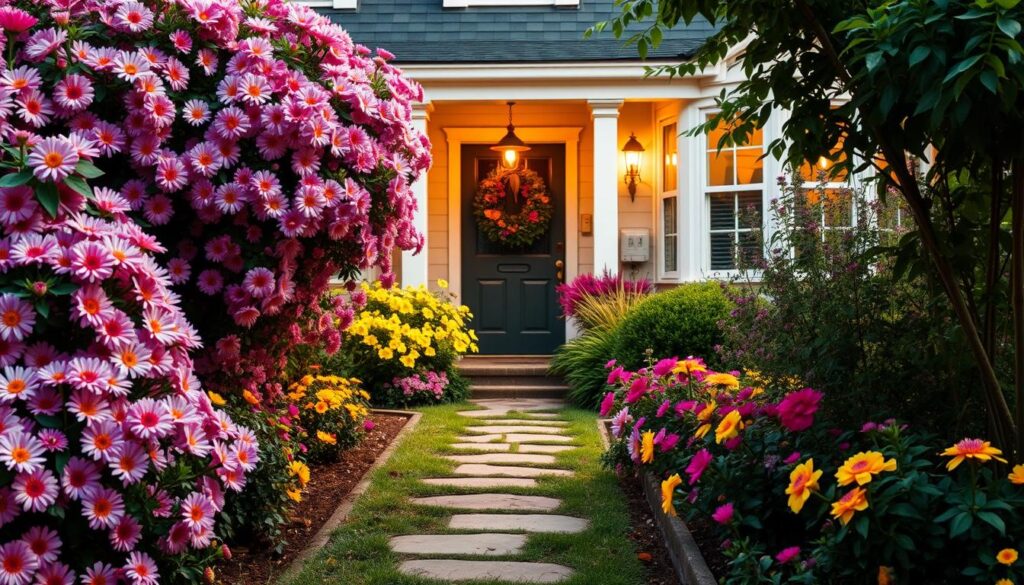
Start by framing your entryway with matching hydrangea pairs. These lush blooms add a welcoming touch and create a cohesive design. For year-round structure, use evergreen boxwoods as anchors. Their consistent greenery ensures your front yard looks polished in every season.
Here are some quick tips to enhance your curb appeal:
- Pair hydrangeas with complementary flowers for a layered effect.
- Use symmetrical layouts to create a sense of order and balance.
- Add mulch to define borders and keep your garden tidy.
With these strategies, your front yard will become a standout feature of your home. Start planning today and enjoy the benefits of a beautiful, value-boosting garden.
Conclusion
Creating a beautiful outdoor space doesn’t have to be overwhelming. By focusing on key themes like pollinator support, color theory, and space optimization, you can craft a yard that’s both functional and stunning. Start small with container gardens to experiment with different ideas and find what works best for your design.
Don’t forget to share your progress! Use #FlowerGardenInspo to connect with others and showcase your creativity. Whether you’re a beginner or a seasoned gardener, every step you take brings you closer to a vibrant and thriving garden.

